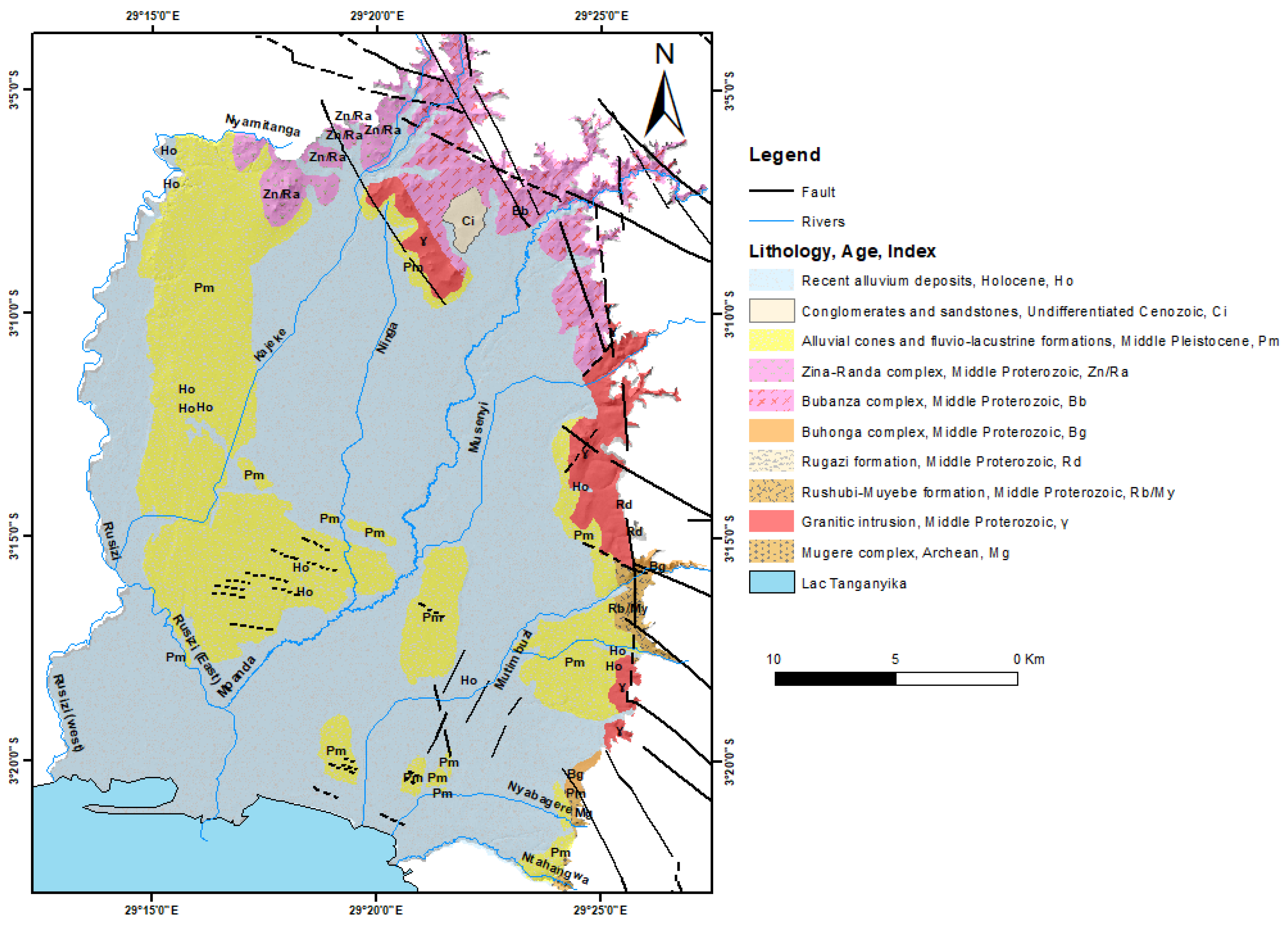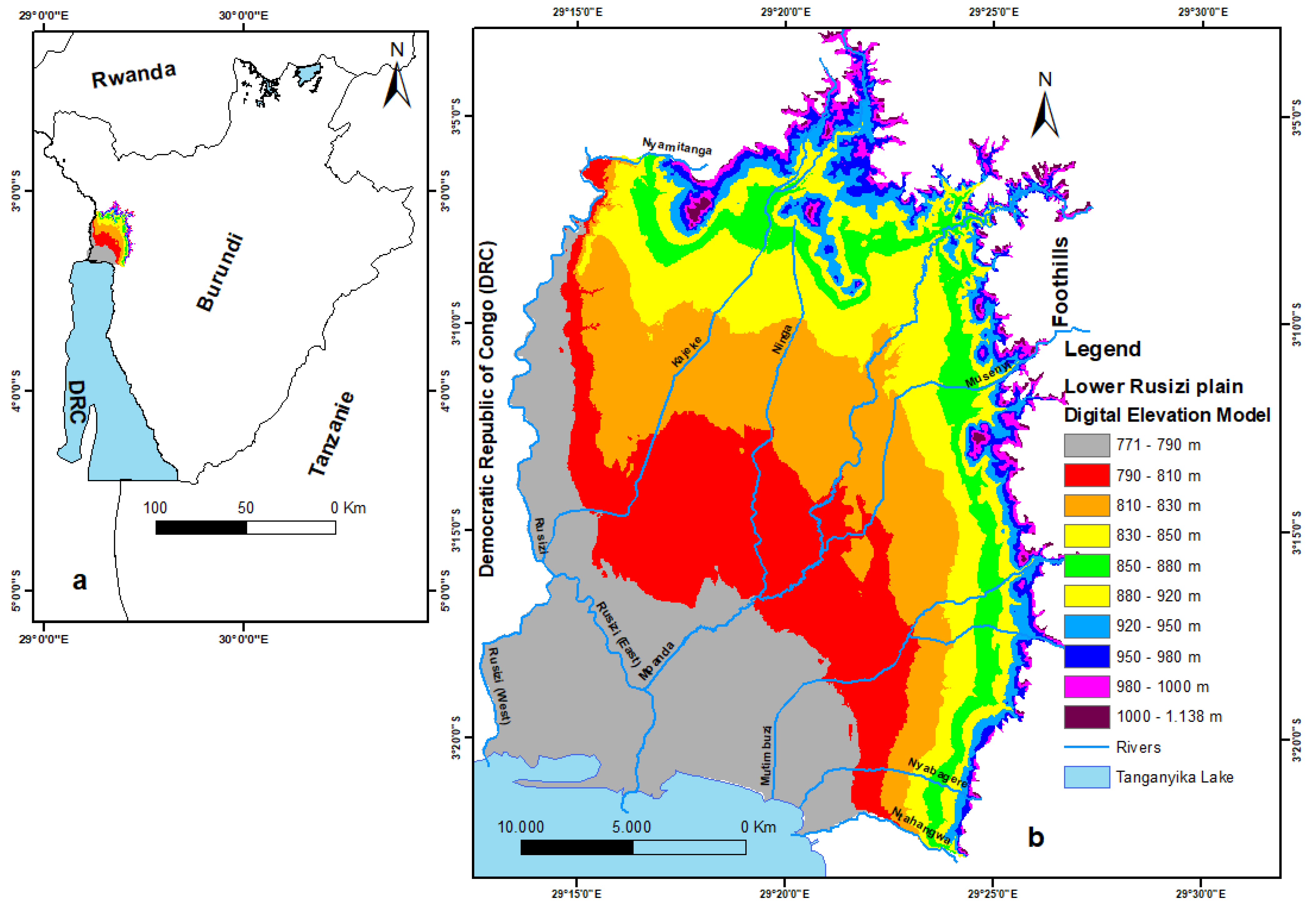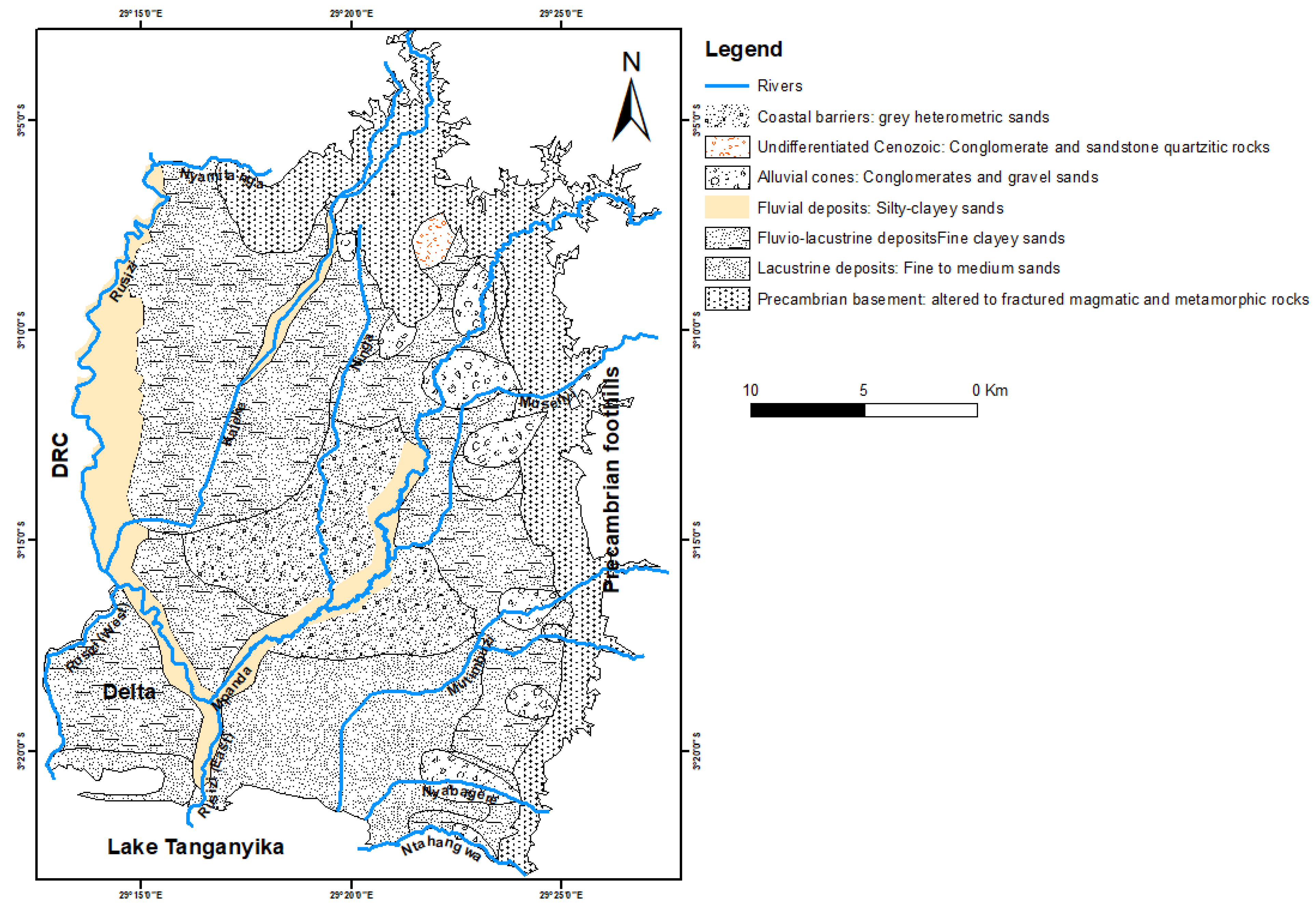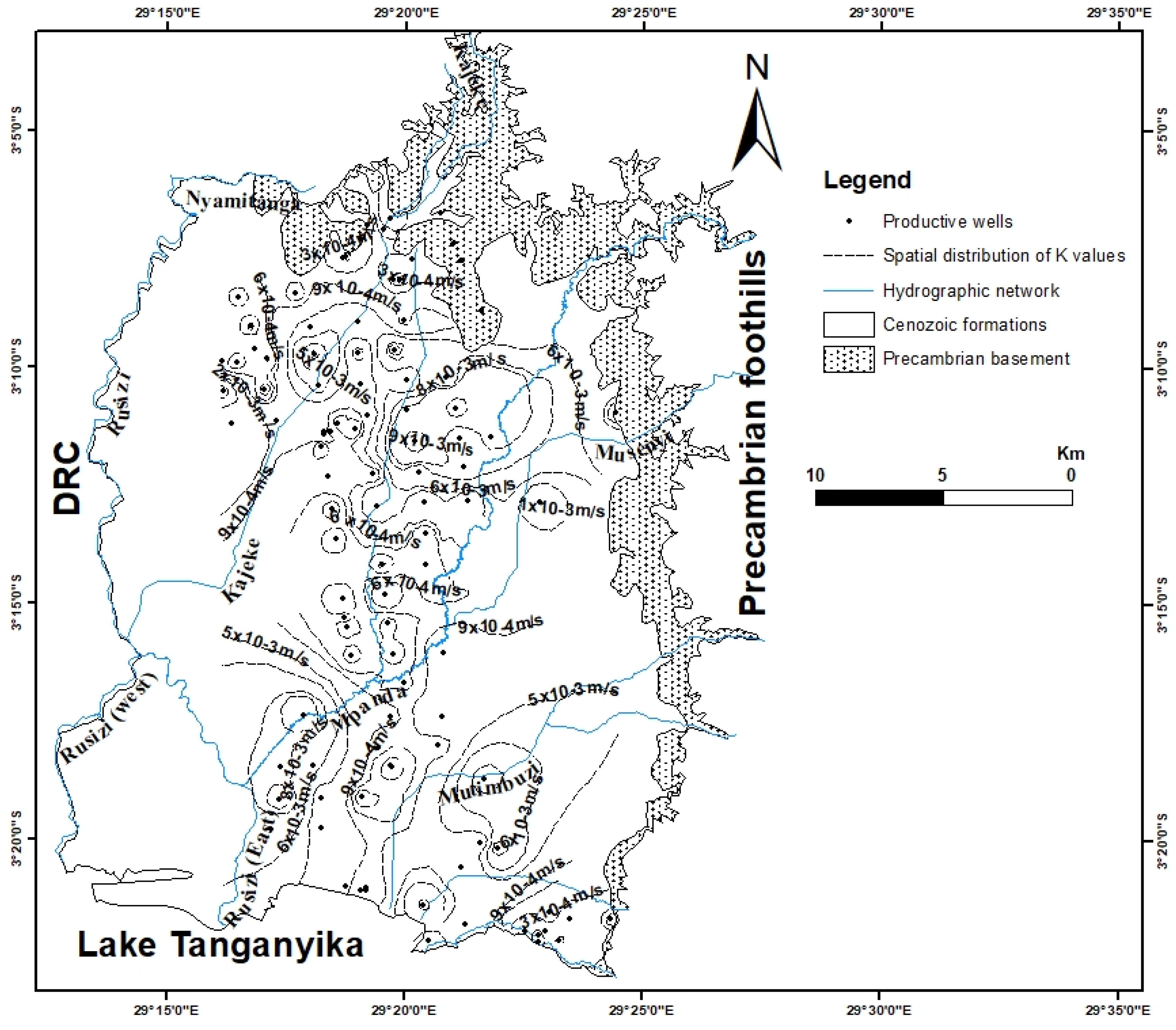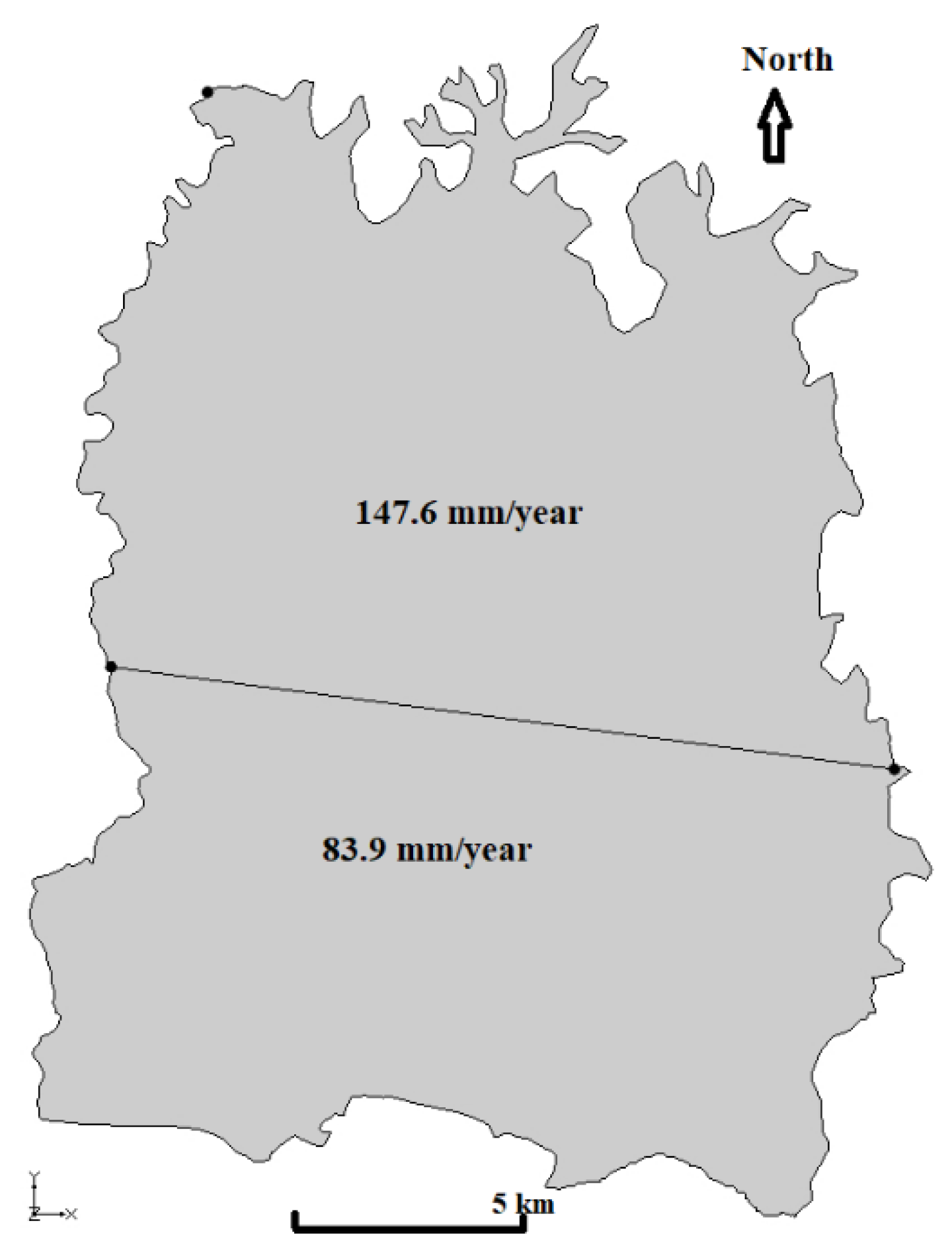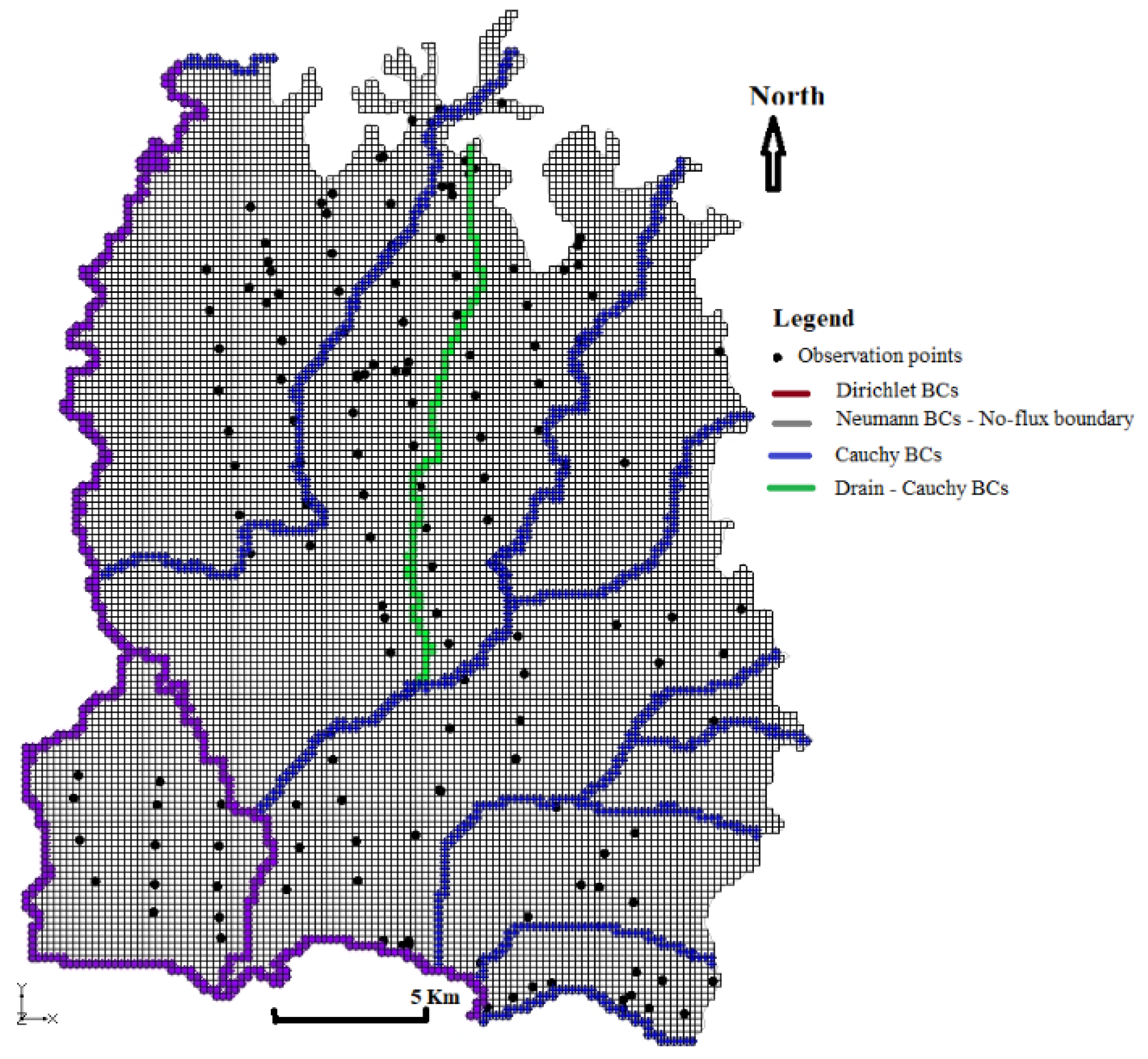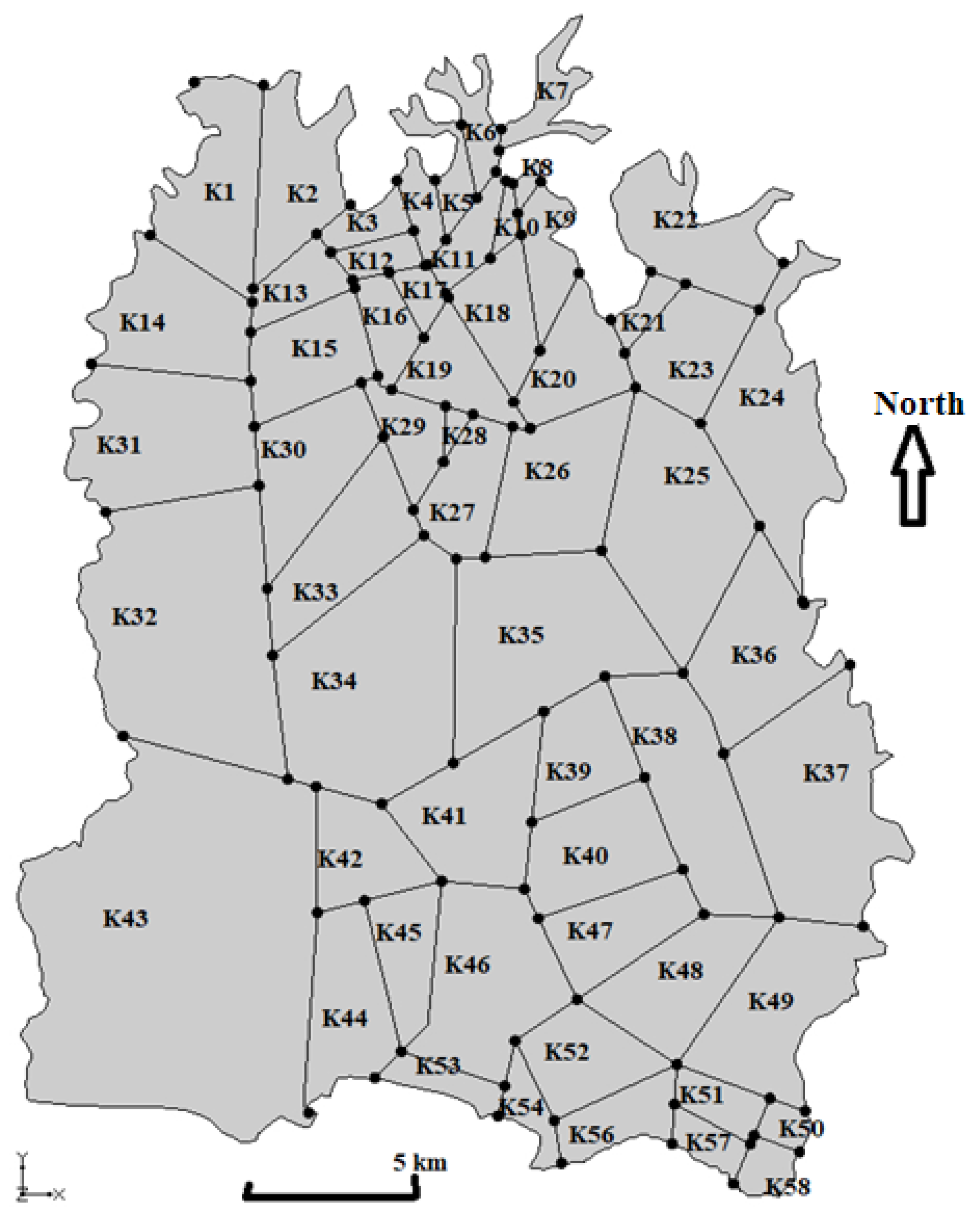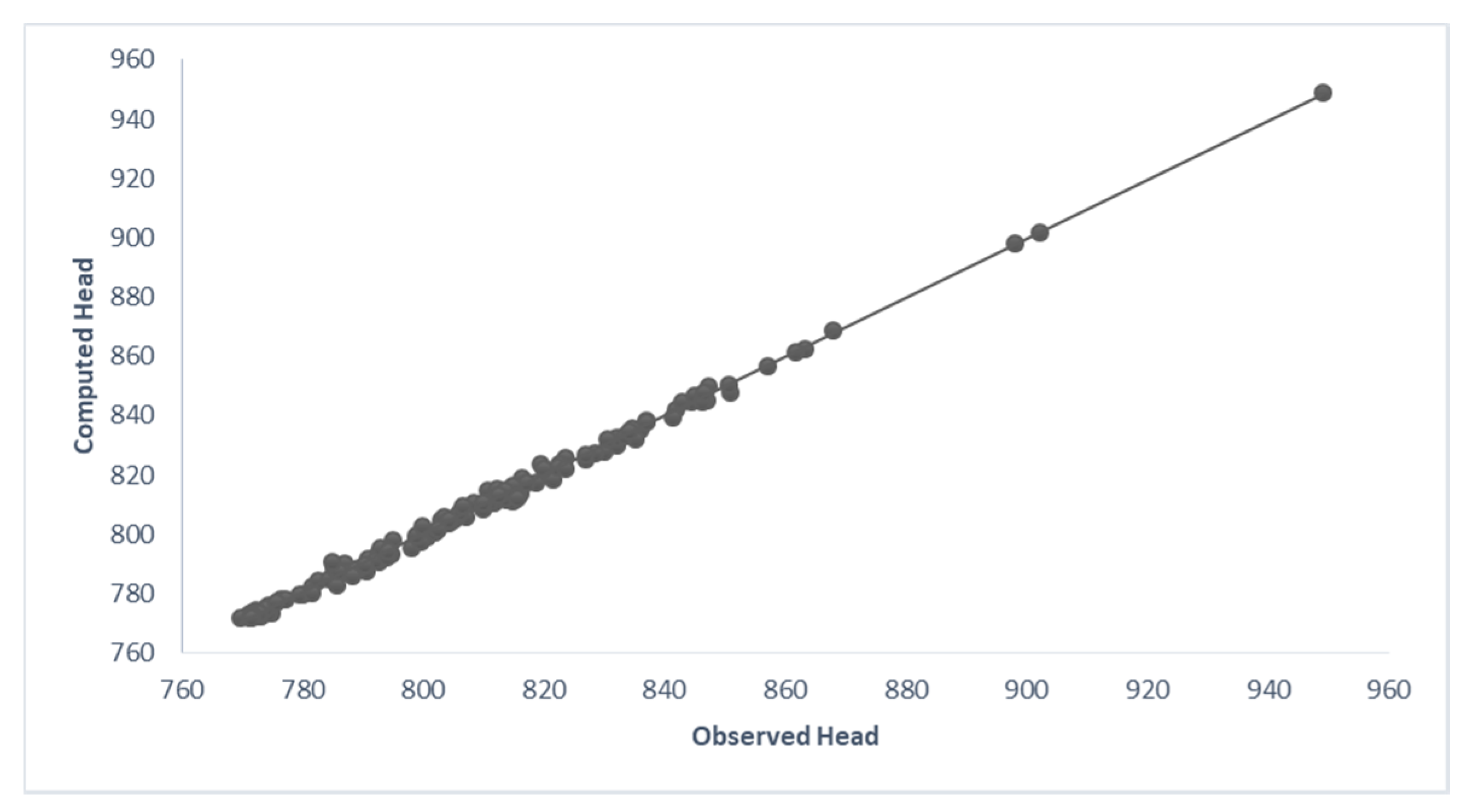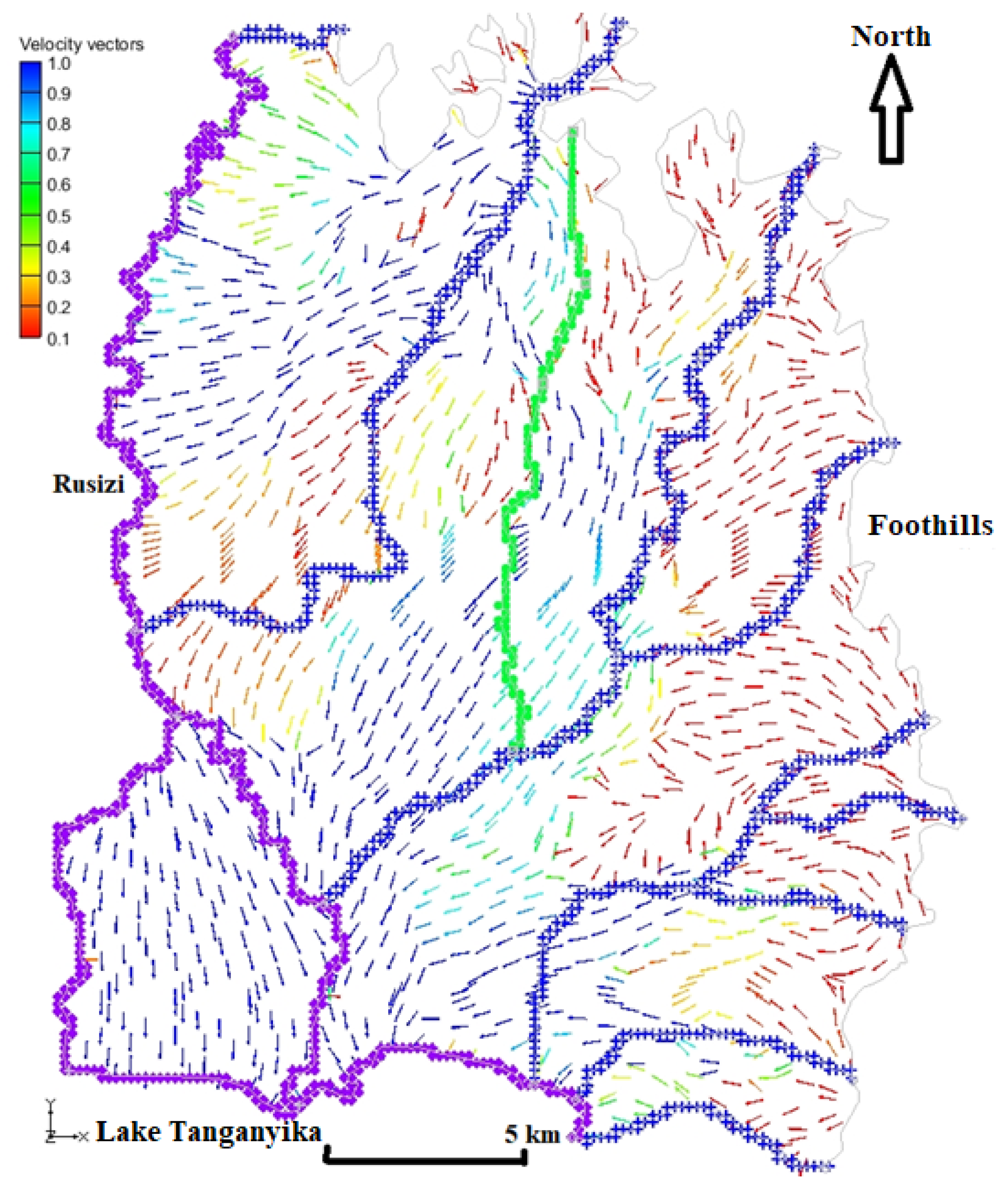2.1.1. Location and Climate
The lower Rusizi plain is located in the northwest of Burundi (
Figure 1) and covers about 632 km
2. This study area lies between southern latitudes of 3°03′00″ to 3°21′00″ and eastern longitudes of 29°12′00″ to 29°27′00″. Burundi has a tropical climate with some areas receiving a lot of rain, but others receiving less rain. In the lower Rusizi plain, the average annual rainfall varies from 800 to 850 millimeters, increasing strongly towards the foothills, where it can reach 1500 millimeters [
1]. The distribution of rainfall during the year is characterized by the alternation of a dry season and a rainy season. The first rains usually arrive towards the end of September and stop normally at the end of May [
2]. Like the rains, the temperatures vary according to the altitude [
2]. The study area is among the warmest areas of Burundi with average annual temperatures above 23 °C [
2]. The hydrographic network in the lower Rusizi plain consists of rivers which originate in the foothills and cross the plain from the northeast to the southwest, flowing either into the Rusizi River or directly into Lake Tanganyika.
2.1.2. Geological Setting
The geology of Burundi is subdivided into four large entities [
4] including the Archean, which is the oldest and the least represented [
5], the Burundian (middle Proterozoic) which covers most of the country hosting all the known mineralization indices in Burundi [
6], the Malagarasian (Neoproterozoic) found in southeastern Burundi [
7] and finally the Cenozoic represented by the tectonic rift deposits of Lake Tanganyika, consisting of lacustrine and fluvio-lacustrine alluvial deposits [
8,
9].
The lower Rusizi plain occupies the bottom of a large geological ditch which, like the northern ditch of Lake Tanganyika, would have resulted from a middle Pleistocene tectonic episode following an earlier episode to be related to the lower Pleistocene or older [
1,
2,
3,
4,
5,
6,
7,
8,
9,
10]. Geological formations are represented by a Precambrian set and a Cenozoic set (Figure 2). The Precambrian outcrops on the eastern border while the fluvio-lacustrine alluviums occupy the remainder of the area [
11]. The western part of this plain is occupied by the recent alluvial deposits of the Rusizi (Holocene), while piedmont deposits from the foothills cover the eastern part [
1]. Current alluvial deposits of several tributaries of Lake Tanganyika (Mutimbuzi) or Rusizi River (Mpanda, Kajeke) have been superimposed on the Middle Pleistocene fluvio-lacustrine alluvium [
1,
2,
3,
4,
5,
6,
7,
8,
9,
10,
11,
12].
Stratigraphically, we can distinguish, in the alluvial plain, Holocene, Middle Pleistocene, and undifferentiated Cenozoic formations [
8] described in
Table 1.
Precambrian outcrops are located at the northern and eastern contacts between the plain and the foothills (
Figure 2 and
Figure 3). These Precambrian outcrops consist of middle Proterozoic magmatic and metamorphic formations [
13] consisting of the complexes of Zina/Randa, Bubanza, and Buhonga, the Rushubi-Muyebe formation, and the granitic intrusions as shown in
Figure 2. A small Archean outcrop is represented in the southeast of the plain and consists of the Mugere complex (
Figure 2).
Figure 2.
Geology of the study area (modified from the geological map of Burundi, Bujumbura sheet [
14]).
Figure 2.
Geology of the study area (modified from the geological map of Burundi, Bujumbura sheet [
14]).
Therefore, the sedimentology of the lower Rusizi plain is represented by six facies [
15] as shown in
Table 2 and
Figure 3.
2.1.3. Hydrogeological Context
Two main drilling periods (1953–1960 and 2007–2015) have occurred in the considered area. During drilling, the depths of the first observed water inflow in the well were systematically recorded, inducing generally, a rise of the water level in the casing of the well [
1,
2,
3]. This can be explained by noncontinuous lenticular layers of lower permeability within the aquifer inducing locally confined or partially confined conditions [
1,
2,
3,
4,
5,
6,
7,
8,
9,
10,
11,
12,
13,
14,
15,
16]. The depth to water measured in the wells, the total thickness of the aquifer, and the position of the lenticular clayey layers are variables. The thickness of the aquifer is relatively low in fluvial deposits (1 to 6 m) but is increased in littoral barriers and lacustrine deposits (more than 12 m).
The results from pumping tests were used to determine locally the hydrodynamic parameters, such as hydraulic conductivity values, which are used further in the calibration of the model. The lithological heterogeneity of the aquifer, as mapped in
Figure 3, indicates that the hydrodynamic parameters calculated from the interpretation of pumping tests (in steady-state conditions and without monitoring piezometers) reflect local hydrogeological conditions around the corresponding wells. The hydraulic conductivities range from 10
−6 and 2.2 × 10
−2 m/s.
Even if the interpretation of the pumping tests cannot be generalized over the whole plain, a general trend in the spatial distribution of these hydraulic conductivity values can be observed (
Figure 4). In general, hydraulic conductivity values decrease from south to north and from west to east and are generally low near the Precambrian foothills. However, this observation cannot be generalized in the alluvial cones investigated by the wells near the Kajeke and Mpanda rivers where hydraulic conductivity values range up to values of 1 × 10
−3 m/s [
3]. In the lacustrine deposits consisting of fine to medium sands, the hydraulic conductivity values vary between 9 × 10
−4 and 9 × 10
−3 m/s. Wells drilled within 300 m of the Lake Tanganyika shore had average hydraulic conductivity values ranging from 6 × 10
−3 m/s to 9 × 10
−4 m/s. In the coarse sand coastal barrier aquifer, the hydraulic conductivity values vary between 3 × 10
−4 and 2.2 × 10
−2 m/s. In the fluvial deposits of the Rusizi River and its tributaries, the hydraulic conductivity values vary between 6 × 10
−3 and 9 × 10
−3 m/s. In the fluvio-lacustrine deposits consisting of fine clayey sand, the hydraulic conductivity values vary between 5 × 10
−5 and 6 × 10
−3 m/s. The wells that were drilled in the Precambrian basement present low hydraulic conductivity values around 1 × 10
−6 m/s. The lowest values are found towards the eastern limit of the plain, while the highest values are found towards the southwest.
Figure 4 shows that in the lower Rusizi plain, some areas have not previously been investigated by any drilling. The model will thus provide an estimation of hydraulic conductivity values in those uninvestigated areas.
The reference piezometric map was established from the data of piezometric level measurements in the ancient drillings (1953–1960) [
1,
2] and has been updated with new data from drilling measurements that were carried out in the study area from 2007 to 2015 [
3]. It reveals a general groundwater flow in the aquifer from the Precambrian basement located to the northeast and east of the plain, towards the southwest. The aquifer–river interactions are not similar from one river to another and from one area to another [
3]. In the Kajeke river basin, the orientation of the potentiometric curves reflects the drainage of this river by the aquifer, while in the Mpanda river basin, the concavity of the potentiometric curves reflects drainage of the aquifer by this river. In other rivers, the orientation of the potentiometric line confirms that those rivers are drained by the aquifer. The concavity of the potentiometric lines oriented towards the East and North-East, except in the Mpanda river basin, also reflects a lateral recharge of the aquifer from the altered or fractured Precambrian formations. From an altitude between 795 m to 770 m, the potentiometric lines do not show a clear concavity and reflect a general balance between the river and the aquifer [
3,
4,
5,
6,
7,
8,
9,
10,
11,
12,
13,
14,
15,
16,
17]. In contrast, at its western limit, this aquifer is drained by the Rusizi River and in the south, Lake Tanganyika constitutes its southern outlet.
The value of the hydraulic gradient varies from 0.3 in the southwest to 5% towards the southeastern limit, with an average value of 1.95% over the whole plain. In the southeast, between the Ntahangwa and Nyabagere rivers (
Figure 5), the potentiometric curves are very tight, indicating low permeability, which is confirmed by the hydraulic conductivity values calculated in this area (10
−4–10
−5 m/s).
